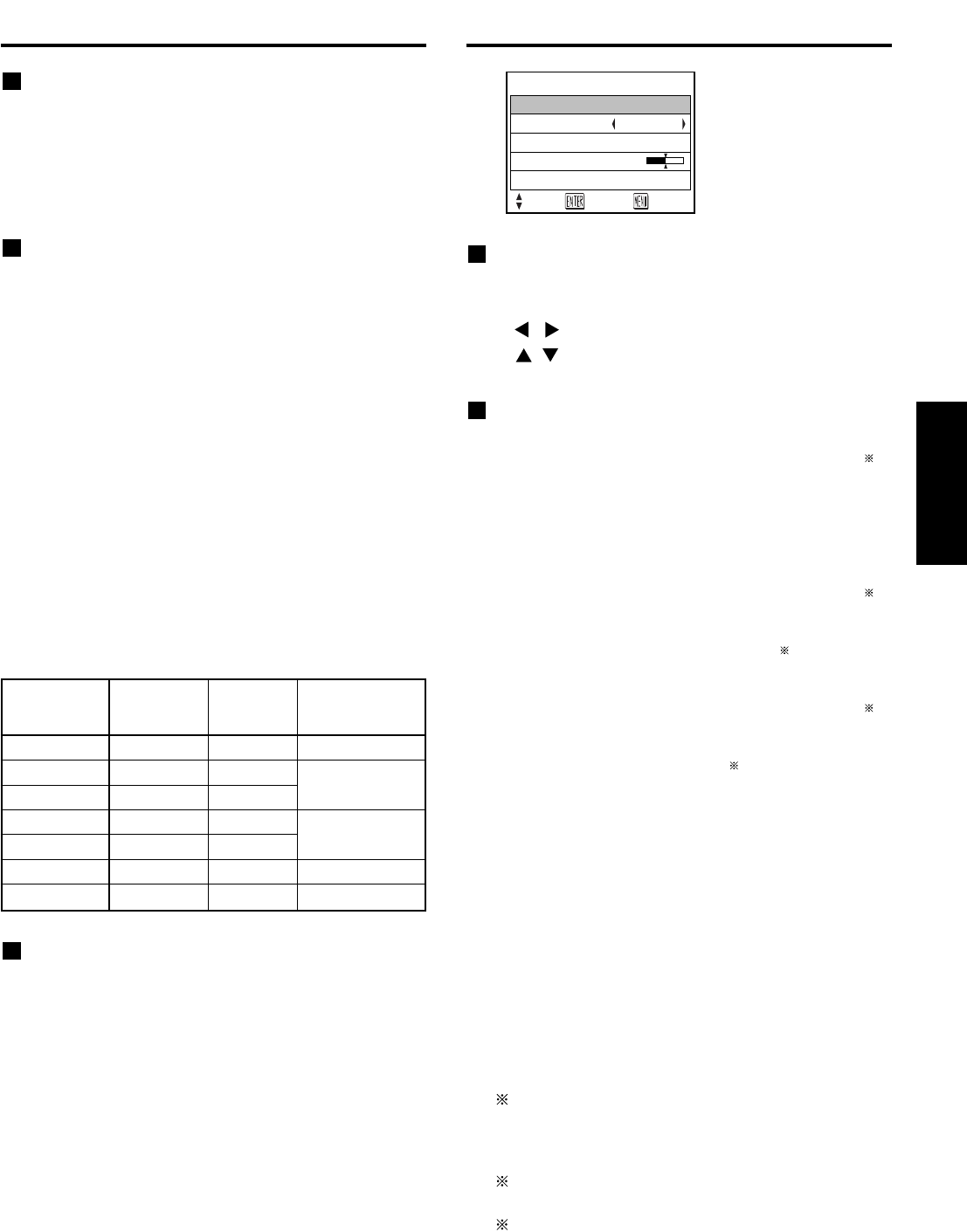
29
ENGLISH
Adjusting the position
POSITION
SELECT RETRN
POSITION
ASPECT 4 : 3
ZOOM
CLOCK PHASE
KEYSTONE
16
ENTER
POSITION
The position where the images are displayed can
be moved here.
: The position is moved horizontally.
: The position is moved vertically.
ASPECT
AUTO : (For S-Video/Video signals only)
At this setting, when S1 video signals
1
are identified as being input to the S-
Video connector or video ID signals are
identified as being input to the video
connector, the images are displayed
after automatically being converted to
the 16:9 aspect ratio.
16:9 : At this setting, when standard signals
2
are input, the images are converted to
the 16:9 aspect ratio and displayed.
When wide-screen signals
3
are input,
the images are displayed with their
inherent aspect ratio intact.
4:3 : At this setting, when standard signals
2
are input, the images are displayed with
their inherent aspect ratio intact. When
wide-screen signals
3
are input, they are
converted by the PT-D5600E to the 4:3
aspect ratio and displayed. With the PT-
DW5000E, the images are reduced in
size and displayed without converting
their aspect ratio so that they will fit onto
a screen with a 4:3 aspect ratio.
S4:3 : Select this setting when using a 16:9
screen.
HV FIT
: At this setting, the images are displayed
to fill the entire screen.
If the aspect ratios of the input signals
and screen differ, the images are
converted into the screen’s aspect ratio
(4:3 for the PT-D5600E or 15:9 for the
PT-DW5000E) and displayed.
1 S1 video signals are 16:9 video signals to
which is added the detection signal output from
the video deck or other unit which supports the
wide-screen format.
2 Here, the standard signal means 4:3 or 5:4
input signals.
3 Here, the wide-screen signals means 16:9,
15:9 or 15:10 input signals.
AI
Gray scale control is exercised to suit the images,
and optimal images with a clear contrast are
projected.
ON : AI compensation is enabled.
OFF : AI compensation is disabled.
TV-SYSTEM
(For S-Video/Video signals)
The setting that corresponds to the TV system is
selected here.
AUTO1 : Standard setting
Automatically selects the TV standard
that matches the input video signal, out
of NTSC, PAL, NTSC4.43, SECAM and
PAL60.
AUTO2 : Automatically selects the TV standard
that matches the input video signal, out
of NTSC, PAL-M, and PAL-N.
• Normally “AUTO1” or “AUTO2” should be
chosen for this option.
• If the video signals are not displayed properly
due to signal deterioration, choose the TV
system that matches the input video signals.
Automatically selected by detecting the
horizontal/vertical scan frequencies and colour sub-
carrier listed in the table below:
SYSTEM
(For RGB/YPBPR signals)
This enables the RGB system or YPBPR system to
be selected.
For the signals which are supported, refer to page
58.
Signal
System
NTSC
NTSC4.43
PAL
PAL-M
PAL-N
SECAM
PLA60
H. Scan
Frequency
(kHz)
15.75
15.75
15.63
15.75
15.63
15.63
15.75
V. Scan
Frequency
(Hz)
60.00
60.00
50.00
60.00
50.00
50.00
60.00
Colour
Subcarrier
(MHz)
3.58
4.43
3.58
4.25 or 4.41
4.43
(Continued on next page)


















